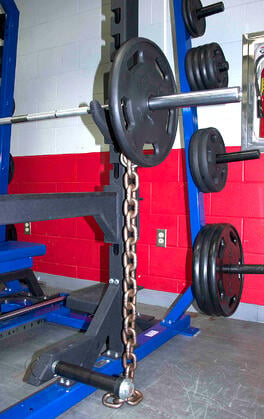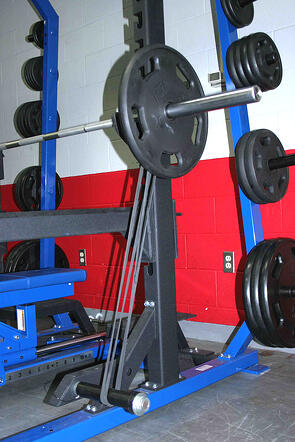 training.
training.
The Force-Velocity Curve
Before going into what the chains and bands do, I first have to set the groundwork and explain what the force-velocity curve is. As you see below, when force (weight lifted) increases, velocity (bar speed) decreases. So at the top where force is high and velocity is low, it is considered maximal strength. As you work down the graph, strength-speed is next. In the middle of the graph, you see power (the rate of force development, or RFD). As you continue down the graph, it becomes speed-strength and finishes with speed, where force is at its lowest and velocity is at its highest.
The reason this is important is that chains and bands give you the ability to develop explosive strength. So instead of benching with high weight and slow velocity (maximal strength), or low weight with fast velocity (speed), you can work in the middle of the graph and accelerate the bar in both the lowering and raising phases of the movement. Without the bands and chains, you have to decelerate the bar about halfway through the raising phase of a bench press, or the bar will fly out of your hands. Bands and chains ensure that you drive the bar as hard as you can, generating a high rate of force through the full range of motion (more on this below). The bottom line: Using bands and chains increases your rate of force development (RFD) and forces you to not let up after you get past your sticking point.
How Bands and Chains Work
Bands and chains do an excellent job of matching your leverage. The bar is lightest when your leverage is at its weakest, and the bar gradually increases in weight as leverage improves. Let’s break this down even further. You are getting ready to bench with 200 pounds on the bar. You add chains that each weigh 30 pounds. So now the bar total is 260 pounds. However, at the start position, half of the chains are lying on the ground, bringing you to a total of 230 pounds. As you bring the weight down to your chest, the bar gets lighter because more of the chains are lying on the ground. So when the bar is at your chest, you bring the weight down to the 200 pounds that you started with. As you press the weight up, more of the chains come off the floor, gradually increasing the bar total back to the 230 pounds at the top. This idea forces you to drive the bar out into full extension without letting up.
The Benefits of Accommodating Resistance
Bands and chains train acceleration and rate of force development, which is great for the development of power. If you are an athlete, the key to improved sport performance is producing more force in less time. This results when an athlete can absorb more force eccentrically (lowering phase), allowing you to apply higher levels of force concentrically (rising phase) in less time. Sport performance is about which athlete can absorb more force, enabling the athlete to produce more power. The biggest improvements that you will see by using this method are increased power, speed, and explosive strength.
Whether or not you are an athlete, using this method is definitely a game changer if your goal is to move a lot of weight and be explosive. I hope this post answers your questions on whether this type of training is right for you. If you are interested in trying this, be sure to ask a coach to make sure the setup is right, and always have a spotter to ensure safety.
This blog was written by Josh Jones, MS, CSCS, USAW, NIFS Athletic Department Trainer and creator of the NIFS Barbell Club. For more information contact Josh by email. Learn more about the NIFS bloggers.
